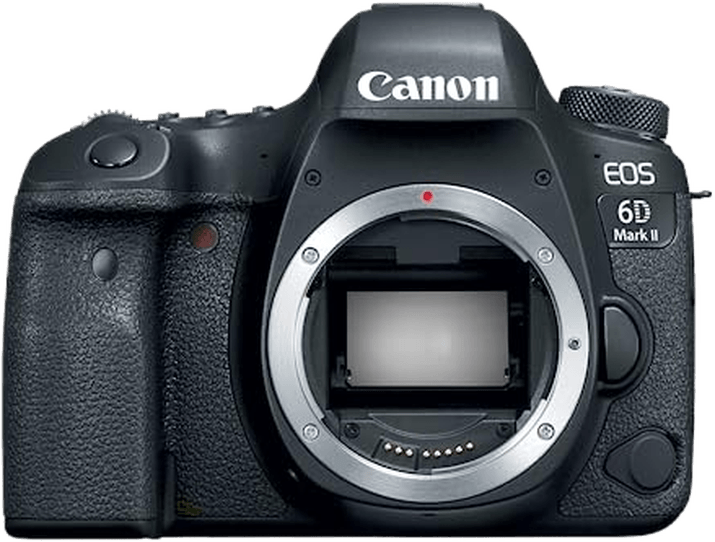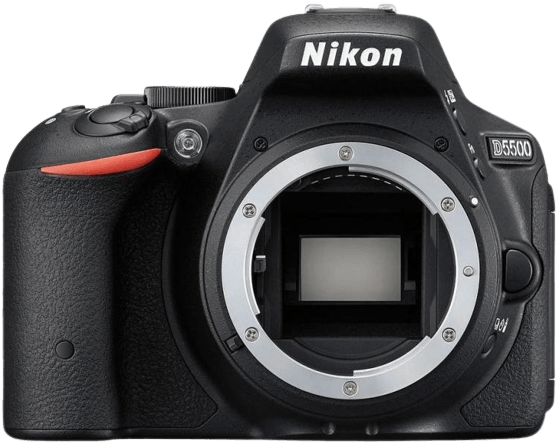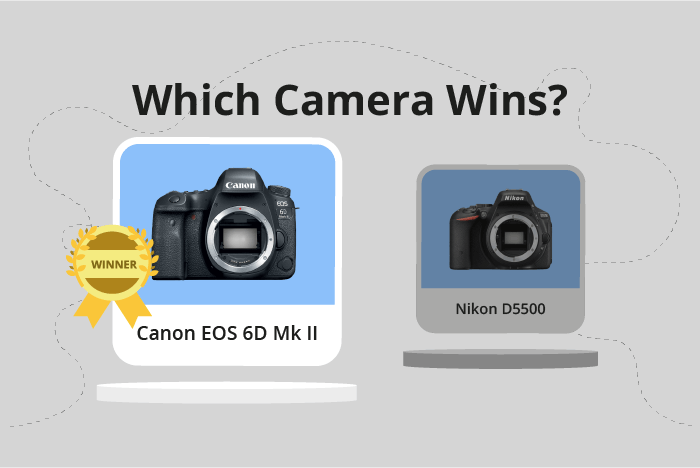Canon EOS 6D Mark II vs Nikon D5500 Comparison
Canon EOS 6D Mark II

Nikon D5500

The Canon EOS 6D Mark II outperforms the Nikon D5500 with a score of 71/100 compared to 61/100. Both cameras share similarities, such as being DSLR cameras, having similar dimensions, and weighing close to one another (Canon: 453g, Nikon: 420g). The Canon model excels with its 2017 release, offering more up-to-date features and technology than the Nikon’s 2015 release.
However, the Nikon D5500 has an advantage in its lower launch price of $900 compared to Canon’s $2000. Despite this, the Canon EOS 6D Mark II’s higher score reflects its superior performance, making it the better choice for photographers looking for a high-quality camera.
Canon EOS 6D Mark II vs Nikon D5500 Overview and Optics
The Canon EOS 6D Mark II takes the lead in the optics comparison with a score of 69/100, while the Nikon D5500 scores 65/100. Both cameras share some common specifications, including a CMOS sensor, absence of image stabilization, and similar megapixel counts (26.2 for Canon and 24.2 for Nikon).
The Canon EOS 6D Mark II excels in various aspects. First, it has a higher shooting speed of 6.5 compared to Nikon’s 5, allowing it to capture fast-moving subjects more efficiently. Second, it boasts a better DXOMARK sensor score of 85, as opposed to Nikon’s 84, which translates to improved image quality. Lastly, the Canon 6D Mark II has a full-frame sensor size, providing better low-light performance and a shallower depth of field.
On the other hand, the Nikon D5500 also has its advantages. Its APS-C sensor size makes it compatible with a wider variety of lenses, as it uses the Nikon F DX lens mount. Furthermore, the Nikon D5500’s Expeed 4 processor provides adequate performance for most photography needs.
Taking these factors into account, the Canon EOS 6D Mark II is the better choice for photographers seeking a high-performance camera with superior image quality and shooting speed. The Nikon D5500, however, remains a viable option for those who prioritize lens compatibility and are satisfied with its processing capabilities.
Canon EOS 6D Mark II vs Nikon D5500 Video Performance
The Nikon D5500 emerges as the winner in video capabilities with a score of 70/100, while the Canon EOS 6D Mark II trails behind with a score of 57/100. Both cameras share common specifications, such as Full HD (1920 x 1080) maximum video resolution and built-in time-lapse functionality.
The Nikon D5500 outperforms the Canon EOS 6D Mark II in terms of video frame rate, offering 60fps compared to the latter’s 30fps. This higher frame rate allows for smoother and more detailed video playback, making the D5500 a superior choice for capturing fast-paced action or creating slow-motion footage.
While the Canon EOS 6D Mark II does not surpass the Nikon D5500 in any specific video-related specification, it still provides adequate capabilities for casual video recording. With Full HD resolution and time-lapse functionality, the 6D Mark II can produce satisfactory results for everyday use.
Considering the video capabilities of both cameras, the Nikon D5500 is the clear winner due to its higher frame rate, allowing for more versatile video capture. However, the Canon EOS 6D Mark II still offers suitable features for those who do not require advanced video capabilities. Ultimately, the choice between these two cameras comes down to the user’s specific needs and preferences for video recording.
Canon EOS 6D Mark II vs Nikon D5500 Features and Benefits
The Canon EOS 6D Mark II outperforms the Nikon D5500 in features, with a score of 83/100 compared to the Nikon’s 59/100. Both cameras share several specifications, such as a touchscreen, flip screen, and WIFI capabilities. However, the Canon 6D Mark II surpasses the Nikon D5500 in certain aspects, while the Nikon D5500 also has its advantages.
The Canon EOS 6D Mark II excels with its 3-inch screen, which has a resolution of 1,040,000 dots. Additionally, this camera includes GPS and Bluetooth functionalities, providing more options for connectivity and location tracking. These features contribute to the Canon 6D Mark II’s higher score and make it a better choice for photographers who prioritize advanced features and seamless connectivity.
On the other hand, the Nikon D5500 has a slightly larger screen size of 3.2 inches, although the screen resolution is slightly lower at 1,037,000 dots. The absence of GPS and Bluetooth capabilities in the Nikon D5500 might be a disadvantage for some users. However, the larger screen size may appeal to those who prefer a bigger display for composing and reviewing photos.
In comparing the features of the Canon EOS 6D Mark II and the Nikon D5500, the Canon clearly takes the lead with its higher score and additional functionalities. The Nikon D5500 may be more suitable for users who prioritize screen size over advanced connectivity options. Ultimately, the choice between these cameras depends on the individual photographer’s preferences and requirements.
Canon EOS 6D Mark II vs Nikon D5500 Storage and Battery
The Canon EOS 6D Mark II triumphs over the Nikon D5500 in storage and battery with a score of 45/100, while the Nikon D5500 scores 35/100. Both cameras have one memory card slot and accept SD, SDHC, and SDXC cards. Neither camera supports USB charging.
The Canon EOS 6D Mark II outperforms the Nikon D5500 in battery life, offering 1200 shots compared to the Nikon’s 820 shots. The Canon uses an LP-E6N battery, providing more power and longevity. This advantage makes the Canon a better choice for extended photography sessions.
On the other hand, the Nikon D5500 does not have any significant advantages in storage and battery compared to the Canon EOS 6D Mark II. Its battery type, the EN-EL14, provides fewer shots per charge.
Ultimately, the Canon EOS 6D Mark II is the superior camera in terms of storage and battery capabilities, making it more suitable for photographers who require longer battery life and reliable storage.
Alternatives to the Canon EOS 6D Mark II and Nikon D5500
Are you still undecided about which camera is right for you? Have a look at these popular comparisons that feature the Canon EOS 6D Mark II or the Nikon D5500:

